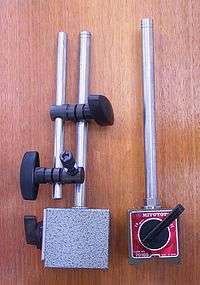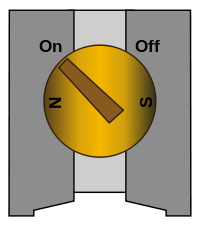Magnetic base


A magnetic base is a magnetic fixture based on a magnet that can effectively be turned "on" and "off" at will; they are often used in optics and metalworking, e.g., to hold a dial indicator.
The vertical post, side arm (as shown in the image at right) and the dial indicator (not shown) are connected by two swivelling connectors. These connectors allow free movement of the arms so that the indicator can be presented to the work in a suitable orientation. The magnetic base may have a "V" cut into the bottom of the base or the back. This "V" allows the base to be attached to a round bar such as the column of a drill press.
The base is made from two blocks of iron, with a round cavity bored through the centre. The halves are joined together with a non-ferrous material such as brass or aluminium. A round permanent magnet is inserted into the bored hole and a handle is attached to allow easy rotation of the magnet. This act of rotation changes the position of the magnetic field.
In the off position, the poles are oriented towards the non-ferrous core. The iron blocks act as keepers by bridging between both poles.
In the on position, the poles are each in one iron half, which then acts as an extension. The field is effectively passing across an air gap (at the base and top). If this gap is bridged with another piece of iron (or steel in our case) it becomes part of the magnetic field's circuit and will be attracted with the full strength of the magnet.
 Base and magnet assembly. Shown in the inverted position. |
 Magnet in Off position. Iron blocks act as keepers. |
 Magnet in On position. Iron blocks act as extension of magnet. |
A magnetic base can therefore be attached in a variety of positions to any attractive surface, allowing the base to be positioned in the best orientation for the part to be tested. Combine this with the flexibility of movement allowed by the arms gives the operator a large range of options in positioning the dial indicator.
An alternative to the post and swiveling connectors is an arrangement whereby a series of interconnecting swivels can be set in position by tightening or loosening a central member. This member may be made from wire rope as it has to be extremely flexible yet strong in tension, the possibilities for positioning this type is probably no more than the two post type but its advantage lies in the fact that there is only one mechanism (screw) to loosen or tighten the arrangement making it easier to use, unlike the other where a third hand is often wished for.